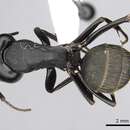en
names in breadcrumbs


Taxonomic history
Forel, 1904c PDF: 380 (m.); Wheeler, 1906h PDF: 324 (s.q.); Imai & Kubota, 1972 PDF: 195 (k.).Combination in Camponotus (Camponotus): Forel, 1914a PDF: 266.Subspecies of Camponotus pennsylvanicus: Forel, 1879a PDF: 56; Forel, 1904c PDF: 380; Ruzsky, 1905b: 239.Subspecies of Camponotus herculeanus: Emery, 1908a PDF: 186; Wheeler, 1909d PDF: 343; Wheeler, 1921c PDF: 544; Ruzsky, 1925b PDF: 42; Kuznetsov-Ugamsky, 1929a PDF: 17; Yasumatsu & Brown, 1951 PDF: 36.Status as species: Bingham, 1903 PDF: 390; Santschi, 1920h PDF: 255; Emery, 1925d PDF: 73; Santschi, 1925f PDF: 88; Ruzsky, 1926 PDF: 108; Wheeler, 1927e PDF: 3; Wheeler, 1928d PDF: 116; Karavaiev, 1929d PDF: 212; Stitz, 1934: 4; Yasumatsu & Brown, 1957 PDF: 49; Arnol'di, 1967 PDF: 1826; Kupyanskaya, 1990a: 169.Senior synonym of Camponotus japonicus miltotus: Yasumatsu & Brown, 1951 PDF: 36.Senior synonym of Camponotus sanguinea: Yasumatsu & Brown, 1951 PDF: 36.Senior synonym of Camponotus japonicus wui: Yasumatsu & Brown, 1951 PDF: 36.Senior synonym of Camponotus aterrimus (and its junior synonym Camponotus japonicus manczshuricus): Radchenko, 1997b PDF: 556.Operaria: Long. 12.5 mm. C. pubescenti Fabr . simillima, differt solummodo corpore magis opaco, pilositate aureo-flava atque pubescentia abdominis paulo densiori et aureo-flava.
Japan (Mus. Leyden).
Camponotus japonicus, commonly known as the Japanese carpenter ant, is a species of ant native to eastern Asia. It is black, and one of the largest ants. A nest has about ten to thousands of individuals, and it can be a pest when it enters households or protects aphids. There are several subspecies of this ant in different areas of Asia, with the largest of the species being located in northern China.
The queen is black, but has microscopic brown hair protruding from the thorax and abdomen. They are 17 millimeters long. Before mating, the queen has four transparent brown wings supported by brown veins. The 12-millimeter-long male has a longer and straighter antennae and a slimmer body. Unlike the workers, both the queen and the male has three ocelli.
The workers are divided into three subcastes based on their size, which varies from 6 to 15 millimeters. The largest subcaste of workers is also called the soldier.
Camponotus japonicus inhabits a wide range, including Japan, Korea, Pakistan, the Philippines, China, Mongolia and Russia (Siberia).[2] It was first identified in India in the state of Arunachal Pradesh in the Tawang district near Kitpi lake, at an elevation of 1700 meters.
This ant serves as a host species for the parasite, Niphanda fusca. The butterfly species will release cuticular hydrocarbons (CHCs) that mimic the CHC of the adult male ant. The ant will then adopt the third instar larva of N. fusca into its nest, feed it mouth-to-mouth, and raise it on its own. This behavior is an example of brood parasitism and obligate parasitism.[3]
Camponotus japonicus, commonly known as the Japanese carpenter ant, is a species of ant native to eastern Asia. It is black, and one of the largest ants. A nest has about ten to thousands of individuals, and it can be a pest when it enters households or protects aphids. There are several subspecies of this ant in different areas of Asia, with the largest of the species being located in northern China.